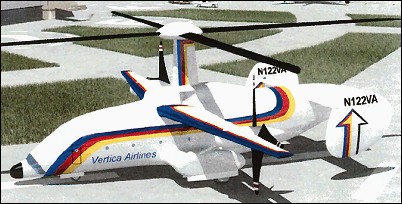TYPE: Convertiplane.
PROGRAMME: Intended to be the largest of a family of convertiplanes; announced June 2000.
DESIGN FEATURES: Extensive use of composites throughout; fuselage constructed in one large piece to keep weight down. Composites thickness varies between 2.54 and 10.16cm. Large stabiliser rotates downwards through 90° as collective is increased to reduce downwash in hover. Hydraulic cylinders at each side of rear ramp prevent aircraft tilting back and act as shock-absorbing tailskid during landings.
FLYING CONTROLS: Conventional and manual. No high-lift devices.
STRUCTURE: Fuselage of lightweight carbon composites. Carbon construction propellers counter rotor torque. Twistable spar eliminates pitch change spindle, bearings and housing. Wing of carbon composites stressed skins; single wing strut to keep weight of wing low. Outer wing sections (23.16m) can be removed for aircraft stowage. Rotor tips each contain 408kg tip weights to provide stored kinetic energy for high density-altitude zero-roll take-offs.
LANDING GEAR: Tricycle type; all wheels retract rearwards and can be retracted and extended while on ground to facilitate cargo handling. Mainwheels housed in sponsons; twin nosewheels. Mainwheels 1.83m diameter and 0.76m wide; nosewheels 0.76m diameter and 0.305m wide; all tyres pressure 4.137 bar.
POWER PLANT: Three turbofan or turboprop engines driving a single gearbox, all located in fuselage with two-speed planetary drive to reverse-pitch propellers; plus second two-speed planetary drive unit to four-blade rotor, latter with overrunning clutch; computerised propeller controller, Airscoop at each side of engine pod; engines (KKBM NK-12MV is under consideration) provide 11.033kW each, continuous; 3,740kW at 9,900m.
ACCOMODATION: As well as primary role of cargo carriage, up to 50 passengers can be carried in commercial airliner configuration. Wraparound windscreen enables pilot to see underslung loads. Large door on port side of fuselage between cockpit and wing.
SYSTEMS: Underslung hook and telescopic refuelling boom can be fitted.
Jane's All the World's Aircraft, 2004-2005
| Technical data for Heliplane Transport
Rotor diameter: 45.72m,
wing span: 38.10m,
fuselage length: 32.31m,
height to top of rotor head: 13.11m,
wheel track: 9.14m,
propeller diameter: 7.32m,
max. take-off weight (STOL): 90,719kg,
max. take-off weight (VTOL): 68,039kg,
empty weight: 40,823kg,
cruising speed at FL150: 531km/h,
cruising speed at FL250: 629km/h,
cruising speed at FL325: 724km/h,
T-O run, STOL: 91m,
VTOL range with max fuel: 8000km,
VTOL range with 20,412kg payload: 1287km
|





